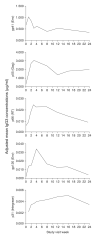Multiple HIV-1-specific IgG3 responses decline during acute HIV-1: implications for detection of incident HIV infection
- PMID: 21832938
- PMCID: PMC3667583
- DOI: 10.1097/QAD.0b013e32834b348e
Multiple HIV-1-specific IgG3 responses decline during acute HIV-1: implications for detection of incident HIV infection
Abstract
Objective: Different HIV-1 antigen specificities appear in sequence after HIV-1 transmission and the immunoglobulin G (IgG) subclass responses to HIV antigens are distinct from each other. The initial predominant IgG subclass response to HIV-1 infection consists of IgG1 and IgG3 antibodies with a noted decline in some IgG3 antibodies during acute HIV-1 infection. Thus, we postulate that multiple antigen-specific IgG3 responses may serve as surrogates for the relative time since HIV-1 acquisition.
Design: We determined the magnitude, peak, and half-life of HIV-1 antigen-specific IgG1 and IgG3 antibodies in 41 HIV-1-infected individuals followed longitudinally from acute infection during the first appearance of HIV-1-specific antibodies through approximately 6 months after infection.
Methods: We used quantitative HIV-1-binding antibody multiplex assays and exponential decay models to estimate concentrations of IgG1 and IgG3 antibodies to eight different HIV-1 proteins including gp140 Env, gp120 Env, gp41 Env, p66 reverse transcriptase, p31 Integrase, Tat, Nef, and p55 Gag proteins during acute/recent HIV-1 infection.
Results: Among HIV-1-specific IgG3 responses, anti-gp41 IgG3 antibodies were the first to appear. We found that anti-gp41 Env IgG3 and anti-p66 reverse transcriptase IgG3 antibodies, in addition to anti-Gag IgG3 antibodies, each consistently and measurably declined after acute infection, in contrast to the persistent antigen-specific IgG1 responses.
Conclusion: The detailed measurements of the decline in multiple HIV-specific IgG3 responses simultaneous with persistent IgG1 responses during acute and recent HIV-1 infection could serve as markers for detection of incident HIV infection.
Figures


References
-
- Tomaras GD, Yates NL, Liu P, Qin L, Fouda GG, Chavez LL, et al. Initial B-cell responses to transmitted human immunodeficiency virus type 1: virion-binding immunoglobulin M (IgM) and IgG antibodies followed by plasma antigp41 antibodies with ineffective control of initial viremia. J Virol. 2008;82:12449–12463. - PMC - PubMed
-
- Cohen MS, Fidler S. HIV prevention 2010: where are we now and where are we going? Curr Opin HIV AIDS. 2010;5:265–268. - PubMed
-
- Parekh BS, Kennedy MS, Dobbs T, Pau CP, Byers R, Green T, et al. Quantitative detection of increasing HIV type 1 antibodies after seroconversion: a simple assay for detecting recent HIV infection and estimating incidence. AIDS Res Hum Retrovir. 2002;18:295–307. - PubMed
-
- Suligoi B, Galli C, Massi M, Di Sora F, Sciandra M, Pezzotti P, et al. Precision and accuracy of a procedure for detecting recent human immunodeficiency virus infections by calculating the antibody avidity index by an automated immunoassay-based method. J Clin Microbiol. 2002;40:4015–4020. - PMC - PubMed
Publication types
MeSH terms
Substances
Grants and funding
LinkOut - more resources
Full Text Sources
Other Literature Sources
Medical

